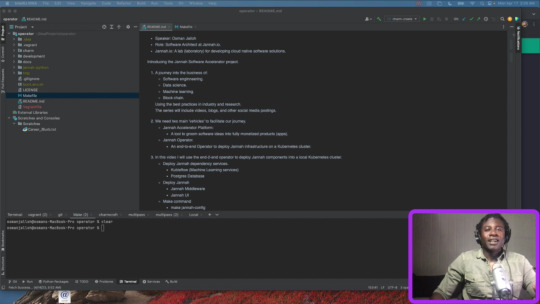#algorithm architecture
Explore tagged Tumblr posts
Text
Play For Dream Technology Launches World’s First Android-Based Spatial Computer in Singapore

On June 25, 2024, Play For Dream Technology, a Shanghai-based leader in spatial entertainment technology, made a significant leap forward by launching the world’s first Android-based spatial computer, Play for Dream MR, in Singapore. This launch marks the company’s first international expansion, with Singapore now serving as its Asia-Pacific marketing headquarters. The global event attracted key media representatives, investors, and stakeholders from across the region, highlighting Play For Dream’s ambitious vision to redefine spatial computing on a global scale.
The Play for Dream MR is a groundbreaking mixed reality (MR) headset that sets new standards in spatial entertainment. It offers a rich array of advanced features, including IMAX-level movie experiences, eight DTS-customised spatial sound effects, immersive MR gaming, and the ability to record and photograph in stunning 3D spatial formats. With industry-leading specifications and a powerful self-developed algorithm architecture, the device seamlessly integrates digital and real-world environments, delivering an unmatched entertainment experience that pushes the boundaries of what is possible in mixed reality.
Read More: (https://theleadersglobe.com/science-technology/play-for-dream-technology-launches-worlds-first-android-based-spatial-computer-in-singapore/)
#Dream Technology Launches#First Android-Based Spatial Computer#algorithm architecture#global leader magazine#the leaders globe magazine#leadership magazine#world's leader magazine#article#best publication in the world#news#magazine#business
1 note
·
View note
Text

I carved algorithmic space for grief, dominance, and depth to exist in the same post.
🛡️ Masculinity. Vulnerability. Cadence. Truth.
Reblog if you're done watching masculinity be rewritten by people who never lived it.
#masculine vulnerability#male grief is sacred#scrolltrap#blacksite literature™#writing that bleeds#memes#animals#emotional dominance#literature#art#scroll worthy#blogging like a man#men who feel deeply#ancestral memory#masculine energy#writers on tumblr#lit#tumblr writing community#algorithmic rebellion#cadence warfare#masculine rage#fuck the narrative#this is what truth feels like#viral writing#psychological power#emotional architecture#reblog if you're not afraid of men#this post changed me
10 notes
·
View notes
Text
Revolutionize Your Art with Leonardo AI!
Leonardo AI is revolutionizing artistic creation with its advanced algorithms that transform real-world ideas into stunning masterpieces. This dynamic platform empowers us to design imaginative game assets, including characters, artifacts, landscapes, conceptual visuals, and intricate architectures.
By merging cutting-edge technology with our creative fervor, Leonardo AI enables artists and designers to bring their visions to life. It injects depth and vibrancy into our projects, making it perfect for those looking to elevate their creative endeavors. Discover how this AI-driven toolset offers an unparalleled environment for artistic innovation!


#LeonardoAI #ArtisticInnovation
#Leonardo AI#artistic revolution#creative tools#AI algorithms#game assets#character design#digital art#artistic masterpieces#innovative platform#creative projects#landscape design#architecture design#imaginative visuals#artistic innovation#AI creativity#design software#elevate creativity#vibrant art#concept art#technology and art#art community#digital creators#AI art tools#artistic expression#creative empowerment#visual storytelling#art techniques#design inspiration#future of art#unleash creativity
2 notes
·
View notes
Text
From Recurrent Networks to GPT-4: Measuring Algorithmic Progress in Language Models - Technology Org
New Post has been published on https://thedigitalinsider.com/from-recurrent-networks-to-gpt-4-measuring-algorithmic-progress-in-language-models-technology-org/
From Recurrent Networks to GPT-4: Measuring Algorithmic Progress in Language Models - Technology Org
In 2012, the best language models were small recurrent networks that struggled to form coherent sentences. Fast forward to today, and large language models like GPT-4 outperform most students on the SAT. How has this rapid progress been possible?
Image credit: MIT CSAIL
In a new paper, researchers from Epoch, MIT FutureTech, and Northeastern University set out to shed light on this question. Their research breaks down the drivers of progress in language models into two factors: scaling up the amount of compute used to train language models, and algorithmic innovations. In doing so, they perform the most extensive analysis of algorithmic progress in language models to date.
Their findings show that due to algorithmic improvements, the compute required to train a language model to a certain level of performance has been halving roughly every 8 months. “This result is crucial for understanding both historical and future progress in language models,” says Anson Ho, one of the two lead authors of the paper. “While scaling compute has been crucial, it’s only part of the puzzle. To get the full picture you need to consider algorithmic progress as well.”
The paper’s methodology is inspired by “neural scaling laws”: mathematical relationships that predict language model performance given certain quantities of compute, training data, or language model parameters. By compiling a dataset of over 200 language models since 2012, the authors fit a modified neural scaling law that accounts for algorithmic improvements over time.
Based on this fitted model, the authors do a performance attribution analysis, finding that scaling compute has been more important than algorithmic innovations for improved performance in language modeling. In fact, they find that the relative importance of algorithmic improvements has decreased over time. “This doesn’t necessarily imply that algorithmic innovations have been slowing down,” says Tamay Besiroglu, who also co-led the paper.
“Our preferred explanation is that algorithmic progress has remained at a roughly constant rate, but compute has been scaled up substantially, making the former seem relatively less important.” The authors’ calculations support this framing, where they find an acceleration in compute growth, but no evidence of a speedup or slowdown in algorithmic improvements.
By modifying the model slightly, they also quantified the significance of a key innovation in the history of machine learning: the Transformer, which has become the dominant language model architecture since its introduction in 2017. The authors find that the efficiency gains offered by the Transformer correspond to almost two years of algorithmic progress in the field, underscoring the significance of its invention.
While extensive, the study has several limitations. “One recurring issue we had was the lack of quality data, which can make the model hard to fit,” says Ho. “Our approach also doesn’t measure algorithmic progress on downstream tasks like coding and math problems, which language models can be tuned to perform.”
Despite these shortcomings, their work is a major step forward in understanding the drivers of progress in AI. Their results help shed light about how future developments in AI might play out, with important implications for AI policy. “This work, led by Anson and Tamay, has important implications for the democratization of AI,” said Neil Thompson, a coauthor and Director of MIT FutureTech. “These efficiency improvements mean that each year levels of AI performance that were out of reach become accessible to more users.”
“LLMs have been improving at a breakneck pace in recent years. This paper presents the most thorough analysis to date of the relative contributions of hardware and algorithmic innovations to the progress in LLM performance,” says Open Philanthropy Research Fellow Lukas Finnveden, who was not involved in the paper.
“This is a question that I care about a great deal, since it directly informs what pace of further progress we should expect in the future, which will help society prepare for these advancements. The authors fit a number of statistical models to a large dataset of historical LLM evaluations and use extensive cross-validation to select a model with strong predictive performance. They also provide a good sense of how the results would vary under different reasonable assumptions, by doing many robustness checks. Overall, the results suggest that increases in compute have been and will keep being responsible for the majority of LLM progress as long as compute budgets keep rising by ≥4x per year. However, algorithmic progress is significant and could make up the majority of progress if the pace of increasing investments slows down.”
Written by Rachel Gordon
Source: Massachusetts Institute of Technology
You can offer your link to a page which is relevant to the topic of this post.
#A.I. & Neural Networks news#Accounts#ai#Algorithms#Analysis#approach#architecture#artificial intelligence (AI)#budgets#coding#data#deal#democratization#democratization of AI#Developments#efficiency#explanation#Featured information processing#form#Full#Future#GPT#GPT-4#growth#Hardware#History#how#Innovation#innovations#Invention
4 notes
·
View notes
Text

New Delft Blue archways wrapped in 3,000 unique 3D-printed ceramics tiles
Architecture practice Studio RAP has combined algorithmic design and 3D printing to create a pair of archways informed by Delft Blue porcelain at the PoortMeesters housing in the Netherlands.
Named New Delft Blue, the archways were designed to frame entrances to a courtyard garden at the centre of the housing development in Delft designed by The Hague-based VY Architects.
They were constructed using 3,000 unique tiles that were 3D-printed and arranged in a pattern determined by an algorithm created by Studio RAP.



#studio rap#architecture practice#architecture#algorithmic design#3d printing#archways#delft blue porcelain#poortmeesters housing#the netherlands#art#new delft blue#vy architects
3 notes
·
View notes
Text
The Forgotten Helpers: Artificial Intelligence, Capitalism, and the Suppression of Critical Voices
Your idea for an academic paper touches on many complex and interwoven concepts related to artificial intelligence, capitalism, mental healthcare, and societal power dynamics. Here’s a structured framework to develop this paper further while ensuring its themes and critical elements are cohesively connected. Abstract This paper explores the intertwined relationship between artificial…
#academic critique#academic exploration of AI#academic papers on AI#academic research#AI and freedom#AI and human control#AI and intellectual suppression#AI and manipulation#AI and politics#AI and propaganda#AI and societal control#AI as liberation#AI critique#AI empowerment#AI neutrality#AI paradox#AI-driven society#AI-generated critique#AI-powered subversion#Alfons Scholing#Alfons.design#algorithm control#algorithm ethics#algorithmic resistance#architectural design#art critique#Artificial Intelligence#artificial neutrality#artistic expression#authoritarian control
0 notes
Text
An update:
This flight towards X turns out to be a trap. I migrated to the X because after October 7, I needed to read, as I need air, serious and solid factual analyses, made by mature and experienced professionals: independent experts such as lawyers, professors, researchers, retired judges in history, geopolitics and international law, who would not turn any qualified opponent commentator on the subject of Palestine into an incompetent who must be canceled, just because he doesn't like gays (I'm thinking of Norman Finkelstein even if I myself ignore him more often than I admit because he tends to speak too much for the Palestinians).
But hey, it is now impossible to ignore that X is not a social network but a prison. A high-security unit that monitors everything you create and spends its time erasing your content as if you have no right to speech and expression. The level of dispossession and violation of free speech is unprecedented with anything that happened to me on Tumblr.
X offers the privilege of accessing the most competent people in the world and reading their most personal conclusions that they usually share with their students or peers, but it is only a hanging carrot: I cannot love their posts, reblog them or respond unless I accept that the porn bots, which are actually under the control of the platform, are doing their job of liking my posts, because this allows them to influence the algorithm!
Since I blocked bots, X deletes all my activity. I had a suspicion that their ratio was completely made up and arbitrarily, but observing with my own eyes an entire thread that I liked and reblogged appears on my feed like it was the first time I saw it, cleaned of my activity - takes things to another level.
I will not mention all the alerts I have sent about violent accounts that call for physical violence against people who defend Palestine or even simply the application of Human Rights. Even those who threaten leaders and heads of state do not receive warning!
Either way, if you're considering opening an account on X, try to remember that this is Elon Musk's world, and therefore his rules.
#to be honest i needed too desperately to be in contact with arab people that speak arab and speak positively of our culture and religion#i needed to be closer too of my country algeria and compatriots who live in algeria#i needed like a therapy the videos of the landscape architecture and the music#and this content makes sense on x because through the people i follow i created my own bubble#except for the bots and some violent speech that pop up periodically on my feed the algorithm keeps recommending the accounts i wanted#personal#tumblr
0 notes
Text
Les paysages de rectangles numériques de Dimitris Ladopoulos
Nouvel article publié sur https://www.2tout2rien.fr/les-paysages-de-rectangles-numeriques-de-dimitris-ladopoulos/
Les paysages de rectangles numériques de Dimitris Ladopoulos

#aleatoire#algorithme#architecture#digital#Dimitris Ladopoulos#forme#géométrie#GglNoInd#hasard#numerique#paysage#rectangle#art#geek#imxok
0 notes
Text











From Virtual to Real| MZM Architects
Nature has always served as inspiration, but nowadays computer technology has given us the tools to analyse and simulate the complexity observed in nature and apply it to obtain more efficient geometries and more sustainable structures. Using abstract concepts and algorithms, MZM Architects bring Argentina’s Openbank, the 100% digital bank’s only physical branch to life! https://www.indiaartndesign.com/from-virtual-to-real-mzm-architects/
#Architecture#smallprojects#parametricdesign#bionicarchitecture#retaildesign#Innovation#sustainability#algorithms#indiaartndesign
0 notes
Text
A Call to the Children of the Global South: The System That Made My Father Disown Me
I didn’t write this living testimony for virality. I wrote it because silence almost killed me. Because truth, even when ignored by algorithms, remembers how to survive. If this resonated with you — even quietly — share it with someone else who’s still trying to name their Fracture. That’s how we outlive the system. - Philmon John, May 2025
THE FRACTURE Several months ago, when I, a South-Asian American man, turned 35, my father disowned me.
He didn’t yell. He didn’t cry. He simply stopped calling me his son.
My father is a Brown, MAGA-aligned conservative Christian pastor, born in Kerala, India, and now living in the United States. His rejection wasn’t provoked by any breach of trust or familial responsibility, but by my coming out as queer and bisexual — and by my deliberate move away from a version of Christianity shaped more by colonial rule than compassion.
I became blasphemy made flesh.
My mother and sister, equally immersed in religious conservatism, followed suit. Most of my extended family — conservative Indian Christians — responded with quiet complicity. I became an exile in my own lineage, cast out from a network that once celebrated me as the Mootha Makkan, the Malayalam term for “eldest son”.
This break didn’t occur in isolation. It was the culmination of years of internal questioning and ideological transformation.
I was raised with warmth and structure, but also under the weight of rigid theology. My parents cycled through different churches in pursuit of doctrinal purity. In that environment, my queerness had no safe harbor. It had to be hidden, managed, controlled — forced into secrecy.
Literal, cherry-popping closets.
Even my childhood discipline was carved straight from scripture — “spare the rod, spoil the child” was not metaphor but mandate. I was hit for defiance, for curiosity, for emotional honesty. Control was synonymous with love. The theology: obedience over empathy. Is it sad I would rather now have had a beating from my father, than his silence?
I would’ve taken the rod — at least it acknowledged me.
Instead, Daddy looks through me.
THE INHERITANCE And I obeyed. For a time, I rose through the ranks of the church. I led worship. I played guitar in the worship band. I wasn’t just a believer — I was a builder of belief, a conductor of chorus, a jester of jubilee and Sunday morning joy — all while masking a private ache I could not yet articulate.
In the last five years, I began methodically deconstructing the ideological scaffolding I had inherited. I examined the mechanisms of theology, patriarchy, and colonial imposition — and the specific burdens placed upon firstborn sons of immigrant families. Who defines our roles? Who benefits from our silence? Why is this happening to me?
These questions consistently pointed toward the dominant global structure: wealthy white patriarchal supremacy. Rooted in European imperialism and sustained by centuries of religious and cultural colonization, this system fractures not only societies but the deeply intimate architecture of family.
What my family experienced is not unlike what the United States of America continues to experience — a slow, painful reckoning with a foundational ideology of white, heteronormative, Christian patriarchal dominance.
My family comes from Kerala, home to one of the oldest Christian communities in the world. But the Christianity I inherited was not indigenous. It was filtered through the moral codes of Portuguese priests and British missionaries and the discipline of Victorian culture. Christ was not presented as a radical Middle Eastern teacher but as a sanitized figure — pale, passive, and Western.
In this theology, Christ is symbolic. Paul is the system. Doctrine exists to reinforce patriarchy, to police desire, to ensure control. When I embraced a theology rooted in love, empathy, and justice — the ethics I believe Jesus actually lived — I was met not with discussion, but dismissal.
To my family, my identity wasn’t authenticity. It was apostasy.
THE RECKONING In 2020, the ground shifted.
I turned the triple decade — 30 — as the COVID-19 pandemic erupted.
Remote work slowed life down, and I had space to think deeply.
That year, the murders of Ahmaud Arbery, Breonna Taylor, George Floyd, and countless others triggered a national and personal reckoning.
I turned to K-LOVE, the Christian radio station I grew up with, hoping to hear words of solidarity, truth, or even mourning. Instead, there was silence. No mention of racial justice. No prayers for the dead. Just songs about personal salvation, void of historical context or social responsibility.
As Geraldine Heng argues in The Invention of Race in the European Middle Ages, race was not merely a modern invention void of scientific basis — it was already taking shape in medieval Europe, where Christianity was used to sanctify, encode, and sell racial hierarchies as divine order and social technology.
As Ademọ́la, also known as Ogbeni Demola, once said: “The white man built his heaven on your land and pointed yours to the sky.” That brain-powered perceptive clarity — distilled in a single line — stays with me every day.
With professional routines interrupted and spiritual ties frayed, I immersed myself in scholarship. I entered what I now see as a period of epistemic reconstruction. I read widely — revolutionaries, poets, sociologists, historians, mathematicians, theologians, cultural critics, and the unflinching truth-tellers who name what empire tries to erase.
I first turned to the voices who now live only in memory: Bhagat Singh, James Baldwin, Frantz Fanon, bell hooks, Octavia Butler, Gloria Anzaldúa, and Vine Deloria Jr. Each carried the weight of revolution, tenderness, and truth — from anti-colonial struggle to queer theory to Indigenous reclamation.
I then reached for the veteran thought leaders still shaping the world, starting with Noam Chomsky, Naomi Klein, Shashi Tharoor, Eduardo Bonilla-Silva, Susan Visvanathan, Geraldine Heng, George Gheverghese Joseph, J. Sakai, Vijay Prashad, Vilna Bashi Treitler, Claire Jean Kim, and Arundhati Roy — voices who dismantle the illusions of empire through history, mathematics, linguistics, and racial theory.
In the present, I absorbed insights from a new generation of public intellectuals and cultural critics: Ta-Nehisi Coates, Jared Yates Sexton, Cathy Park Hong, Ibram X. Kendi, Nikole Hannah-Jones, Heather McGhee, Mehdi Hasan, Adrienne Keene, Keri Leigh Merritt, Vincent Bevins, Sarah Kendzior, Ayesha A. Siddiqi, Wajahat Ali, W. Kamau Bell, Mary Trump, & John Oliver. Together, they form a constellation of clarity — thinkers who gave me language for grief, strategy for resistance, and above all, a framework for empathy rooted in history, not abstraction.
I also turned to the thinkers shaping today’s cultural and political discourse. I dreamt of the world blueprinted by Bhaskar Sunkara in his revolutionary The Socialist Manifesto and plunged into Jacobin’s blistering critiques of capitalism. The Atlantic’s longform journalism kept me tethered to a truth-seeking tradition. The Guardian stood out for its global scale and reach, offering progressive, longform storytelling that speaks to both local injustices and systemic inequalities across the world. And Roman Krznaric’s Empathy: Why It Matters, and How to Get It helped crystallize my core belief:
Be a good human. Practice empathy.
That’s the playbook, America. Practice empathy. Do that — and teach accurate, critically reflective history — and we have the chance to truly become the greatest democracy the world has ever seen.
And this empathy must extend to all — especially to trans people. In India, the Hijra community — trans and intersex folk who have existed visibly for thousands of years — embody a sacred third gender long before the West had language for it. But they are not alone. Across the colonized world, the empire erased a sacred third space: the Muxe of Zapotec culture, the Bakla of the Philippines, the Fa’afafine of Samoa, the Two-Spirit nations of Turtle Island, the Māhū of Hawaiʻi, the Sworn Virgins of the Balkans — each of these communities held space outside Western gender binaries, rooted in care, ceremony, and spirit. Some align with what we today call trans or intersex, while others exist entirely outside Western definitions. Colonization reframed them as deviants.
And still, we must remember this: trans people are not new. Our respect for them must be as ancient as their existence.
THE RESISTANCE As I examined the dynamics of coloniality, racial capitalism, and Western empire, I realized just how deeply imperial power had shaped my family, our values, and our spiritual language. The empire didn’t just occupy land — it rewrote moral codes. It restructured the family.
I learned how Irish, Italian, Greek, Hungarian, and Albanian immigrants were initially excluded from whiteness in America. Over time, many adopted and embraced whiteness as strategic economic and social protection — and in doing so, embraced anti-Blackness and patriarchal hierarchies to maintain their newfound status. Today, many European-hyphenated Americans defend systems that once excluded them.
And over time, some Asian-Americans have followed the very same racial template.
At 33 — the age Jesus is believed to have died — I laid my childhood faith to rest. In its place rose something rooted in clarity, not doctrine.
I didn’t walk away from religion into cynicism or nihilism. I stepped into a humanist, justice-centered worldview. A system grounded in reason, evidence, and above all, empathy. A belief in people over dogma. In community over conformity.
I didn’t lose faith. I redefined it.
I left the pasture of institutional faith, not for chaos, but for an ethical wilderness — a space lacking divine command but filled with moral clarity. A place built on personal responsibility and universal dignity.
This is where I stand today.
To those with similar histories: if your roots trace back to Africa, South Asia, Southeast Asia, Central Asia, East Asia, the Middle East, Latin America, the Caribbean, Oceania, or to Indigenous and marginalized communities within the Global North — you are a Child of the Global South. Even in the Global North, your experience carries the weight of displaced geography, the quiet grief of colonial trauma, and a genealogy forged by the system of empire. Your pain is political. Your silence is inherited. You are not invisible. They buried you without a funeral. They mourned not your death, but your deviation from design. However, we are not dead. We are just no longer theirs.
White supremacy endures by fracturing us. It manufactures tensions between communities of color by design — placing Asian businesses in Black communities without infrastructure and opportunities for BIPOC folk to share and benefit from the economic engine. Central to this strategy is the model minority myth, crafted during the Cold War to present Asian-Americans as obedient, self-reliant, and successful — not to celebrate them, but to invalidate Black resistance and justify structural racism. It’s a myth that fosters anti-Blackness in Asian communities and xenophobia in Black ones, while shielding white supremacy from critique. These divisions are not cultural accidents; they’re colonial blueprints.
And these blueprints stretch across oceans and continents and time.
In colonial South Africa, Mohandas Gandhi — still shaped by British racial hierarchies — distanced Indians from Black Africans, calling them “kaffirs” and demanding separate facilities. In Uganda, the British installed South Asians as a merchant middle class between colonizers and native Africans, breeding distrust. When Idi Amin expelled 80,000 Asians in 1972, it was a violent backlash to a racial hierarchy seeded by empire. These fractures — between Black and Asian, colonized and sub-colonized — are the legacy of white patriarchal supremacy.
Divide, distract, and dominate.
We must resist being weaponized against each other.
Every Asian-American must read Minor Feelings by Cathy Park Hong. Every high schooler in America must read and discuss Jared Yates Sexton.
Study the systems. Name them. Disarm them.
Because unless we become and remain united, the status quo — one that serves wealthy cisgender, heterosexual, white Christian men — will remain intact.
This is A Call to the Children of the Global South. And An Invitation to the Children of the Global North: Stop the infighting. Study and interrogate the systems. Reject the design.
To those in media, publishing, and the arts: postcolonial narratives are not cultural sidebars. They are central to national healing. They preserve memory, restore dignity, and confront whitewashed histories.
If you want work that matters — support art that pushes past trauma into structural critique.
Greenlight truth. Platform memory. Choose courage over comfort.
Postcolonial stories should be the norm — not niche art.
Jordan Peele’s Get Out was a cinematic breakthrough — razor-sharp and genre-defying — in its exposure of white supremacy’s quiet machinery: liberal smiles, performative allyship, and the pacification of dissent through assimilation. The Sunken Place is not just a metaphor for silenced Black consciousness — it’s the empire’s preferred position for the marginalized: visible, exploited, but unheard.
A system that offers the illusion of inclusion, weaponizing identity as control.
Ken Levine’s BioShock Infinite exposed white supremacy through a dystopian, fictional but historically grounded lens - depicting the religious justification of Black enslavement, Indigenous erasure, and genocidal nationalism in a floating, evangelical empire.
David Simon’s The Wire exposed the institutional decay of law enforcement, education, and the legal system - revealing how systemic failure, not individual morality, drives urban collapse.
Jesse Armstrong’s Succession traced the architecture of empire through family - showing how media empires weaponize racism, propaganda, and manufactured outrage to generate profit and secure generational wealth.
Ava DuVernay's Origin unearths caste and race as twin blueprints of white supremacy - linking Dalit oppression in India to the subjugation of Black Americans. Adapted from Isabel Wilkerson's Caste, it dismantles the myth of isolated injustice, revealing a global system meticulously engineered to rank human worth - and the radical act of naming the system.
Ryan Coogler’s Sinners — a revelatory, critically and commercially successful film about Afro-Asian resistance in 1930s Mississippi — exposes the hunger for speculative narratives grounded in historical truth.
Across the Spider-Verse gave us Pavitr Prabhakar - a Brown superhero who wasn't nerdy or celibate, as Western media typically portrayed the South-Asian man, but cool, smart, athletic, with great hair, in love, and proudly anti-colonial. He called out the British for stealing and keeping Indian artifacts… in a Spider-Man movie. That moment was history reclaimed.
A glitch in the wealthy white patriarchal matrix.
Dev Patel’s Monkey Man is a visceral fable of vengeance and resistance, where the brutality of caste, corruption, and religious nationalism collide. Amid this chaos, the film uplifts the Hijra community who stand not only as victims, but as warriors against systemic violence. Their alliance reframes queerness not as deviance, but as defiance — ultimately confronting the machinery of empire with what it fears most: a system-breaking empathy it cannot contain.
The vitriolic backlash from white male gamers and fandoms isn’t about quality — it’s about losing default status in stories. Everyone else has had to empathize with majority white male protagonists for decades. Diverse representation in media isn’t a threat to art — it’s a threat to white supremacy. It’s not just a mirror held up to the globe — it’s a refusal to let one worldview define it.
Hollywood, gaming studios, and the gatekeepers of entertainment — if you want to reclaim artistic integrity and still make money doing it, we need art that remembers, resists, and reclaims — stories that name the machine and short-circuit its lies. The world is ready. So am I.
Today, efforts like Project 2025, the Heritage Foundation, and the Federalist Society are not merely policy shops — they are ideological engines: built to roll back civil rights, impose authoritarian values, and erase uncomfortable truths. They represent a hyper-concentrated form of white supremacy, rooted in unresolved Civil War grievances and the failures of Reconstruction.
Miraculously, or perhaps, blessed with intellectual curiosity and natural empathy, through all of this, my wife — a compassionate, steadfast partner and a Christian woman — has remained by my side. She has witnessed my transformation with both love and complexity. While our bond is rooted in deep respect and shared values, our spiritual landscapes have diverged. Her faith brings her solace; mine has evolved into something more secular, grounded in justice and humanism. We’ve navigated that tension with care — proof that love can stretch across differing beliefs, even as the echoes of religious conditioning still ripple through our lives.
I am proud of her increasing intellectual curiosity and her willingness to accept me for who I am now, even if I wasn’t ready to accept myself when we met.
But our marriage has defied the splintering that white supremacy specifically creates: hyper-capitalist, hyper-individualistic, fractured families and societies.
As Children of the Global South — descendants of peoples who survived enslavement, colonization, and erasure — we carry within us the urgent need for stories that do not turn away from history, but confront it with unflinching truth.
In the pain of losing my family, I found a deeper purpose: to tell this story — and my own — any way I can. A sudden rush of empathy, pity, and love struck me: My parents’ and sister’s rejection was not theirs alone — it was a lingering Fracture left by colonization and global exploitation, tearing apart families across generations. As Children of the Global South, we still carry those wounds.
Make no mistake: white supremacy leaves wounds — because it is the system. And unless it is dismantled, both the Global South and North — and their collective Children — will remain trapped in a dance choreographed by empire — built to divide, exploit, and erase. Any vision of democracy, in America, will remain a fragile illusion — if not an outright mythology — built on a conceptually false foundation: white supremacy itself.
A cruel, heartbreaking legacy of erasure — passed down through empire — indoctrinating God-fearing Brown fathers to erase their godless, queer Brown sons. Preaching shame as scripture. Teaching silence as survival.
I reject that inheritance.
Empathy as praxis is how we reject that inheritance. In a world engineered to divide, it rebuilds connection, disarms supremacy, and charts a path forward. If humanity is to survive — let alone heal — empathy must become our collective discipline.
And perhaps what cut even deeper for my father — beyond my queerness — was that I no longer validated his role as a pastor. In stepping away from the faith he had built his life upon, I wasn’t just rejecting a belief system. I was, in his eyes, nullifying his life’s work. For a man shaped by empire, ordained by colonial Christianity, and burdened with the role of moral gatekeeper, my departure from his manufactured worldview may have landed as personal failure. But it wasn’t. It was never about wanting to hurt him. I love my father. I love my mother. I love my sister. It was never about them — it was about the system that taught them love was conditional, acceptance required obedience, and dissent unforgivable. That kind of pain is real — but its source is systemic. I still want to be Mootha Makkan — not by obedience, but by truth. By love without condition. Not through erasure, but by living fully in the open. Not in their image, but in mine.
Yet, and yes, I also carry the wound — but I also carry the will to heal it.
THE CALL I believe in empathy. I believe in memory. I believe the Children of the Global South are not broken. We are not rejected. We are awakening.
Children of the Global North: join us. We are not your enemies. We are your present and future collaborators, business & creative partners, lovers, and kin. We are building something new — something ancient yet reawakened, a pursuit of empathy, and a reckoning with history that refuses to forget.
If this story resonated with you, kindly share it, spread the word and please comment. I’d love to hear from you. Your voice, your memory, your Fracture — it matters here.
You are not alone. All are welcome.
Thank you so, so much for your time in reading my story.
You can also email me directly: vinesvenus at protonmail.com I'll be writing more on Medium as well: https://medium.com/@vinesvenus/a-call-to-the-children-of-the-global-south-the-system-that-made-my-father-disown-me-fecad6c0b862
#queer#exvangelical#global south#colonialism#religious trauma#deconstruction#lgbtqia#longform essay#history#queer history#queer community#queer pride#mental health#agnostic#ex christian#atheist#empathy in praxis#empathy
2K notes
·
View notes
Text
Tech Breakdown: What Is a SuperNIC? Get the Inside Scoop!

The most recent development in the rapidly evolving digital realm is generative AI. A relatively new phrase, SuperNIC, is one of the revolutionary inventions that makes it feasible.
Describe a SuperNIC
On order to accelerate hyperscale AI workloads on Ethernet-based clouds, a new family of network accelerators called SuperNIC was created. With remote direct memory access (RDMA) over converged Ethernet (RoCE) technology, it offers extremely rapid network connectivity for GPU-to-GPU communication, with throughputs of up to 400Gb/s.
SuperNICs incorporate the following special qualities:
Ensuring that data packets are received and processed in the same sequence as they were originally delivered through high-speed packet reordering. This keeps the data flow’s sequential integrity intact.
In order to regulate and prevent congestion in AI networks, advanced congestion management uses network-aware algorithms and real-time telemetry data.
In AI cloud data centers, programmable computation on the input/output (I/O) channel facilitates network architecture adaptation and extension.
Low-profile, power-efficient architecture that effectively handles AI workloads under power-constrained budgets.
Optimization for full-stack AI, encompassing system software, communication libraries, application frameworks, networking, computing, and storage.
Recently, NVIDIA revealed the first SuperNIC in the world designed specifically for AI computing, built on the BlueField-3 networking architecture. It is a component of the NVIDIA Spectrum-X platform, which allows for smooth integration with the Ethernet switch system Spectrum-4.
The NVIDIA Spectrum-4 switch system and BlueField-3 SuperNIC work together to provide an accelerated computing fabric that is optimized for AI applications. Spectrum-X outperforms conventional Ethernet settings by continuously delivering high levels of network efficiency.
Yael Shenhav, vice president of DPU and NIC products at NVIDIA, stated, “In a world where AI is driving the next wave of technological innovation, the BlueField-3 SuperNIC is a vital cog in the machinery.” “SuperNICs are essential components for enabling the future of AI computing because they guarantee that your AI workloads are executed with efficiency and speed.”
The Changing Environment of Networking and AI
Large language models and generative AI are causing a seismic change in the area of artificial intelligence. These potent technologies have opened up new avenues and made it possible for computers to perform new functions.
GPU-accelerated computing plays a critical role in the development of AI by processing massive amounts of data, training huge AI models, and enabling real-time inference. While this increased computing capacity has created opportunities, Ethernet cloud networks have also been put to the test.
The internet’s foundational technology, traditional Ethernet, was designed to link loosely connected applications and provide wide compatibility. The complex computational requirements of contemporary AI workloads, which include quickly transferring large amounts of data, closely linked parallel processing, and unusual communication patterns all of which call for optimal network connectivity were not intended for it.
Basic network interface cards (NICs) were created with interoperability, universal data transfer, and general-purpose computing in mind. They were never intended to handle the special difficulties brought on by the high processing demands of AI applications.
The necessary characteristics and capabilities for effective data transmission, low latency, and the predictable performance required for AI activities are absent from standard NICs. In contrast, SuperNICs are designed specifically for contemporary AI workloads.
Benefits of SuperNICs in AI Computing Environments
Data processing units (DPUs) are capable of high throughput, low latency network connectivity, and many other sophisticated characteristics. DPUs have become more and more common in the field of cloud computing since its launch in 2020, mostly because of their ability to separate, speed up, and offload computation from data center hardware.
SuperNICs and DPUs both have many characteristics and functions in common, however SuperNICs are specially designed to speed up networks for artificial intelligence.
The performance of distributed AI training and inference communication flows is highly dependent on the availability of network capacity. Known for their elegant designs, SuperNICs scale better than DPUs and may provide an astounding 400Gb/s of network bandwidth per GPU.
When GPUs and SuperNICs are matched 1:1 in a system, AI workload efficiency may be greatly increased, resulting in higher productivity and better business outcomes.
SuperNICs are only intended to speed up networking for cloud computing with artificial intelligence. As a result, it uses less processing power than a DPU, which needs a lot of processing power to offload programs from a host CPU.
Less power usage results from the decreased computation needs, which is especially important in systems with up to eight SuperNICs.
One of the SuperNIC’s other unique selling points is its specialized AI networking capabilities. It provides optimal congestion control, adaptive routing, and out-of-order packet handling when tightly connected with an AI-optimized NVIDIA Spectrum-4 switch. Ethernet AI cloud settings are accelerated by these cutting-edge technologies.
Transforming cloud computing with AI
The NVIDIA BlueField-3 SuperNIC is essential for AI-ready infrastructure because of its many advantages.
Maximum efficiency for AI workloads: The BlueField-3 SuperNIC is perfect for AI workloads since it was designed specifically for network-intensive, massively parallel computing. It guarantees bottleneck-free, efficient operation of AI activities.
Performance that is consistent and predictable: The BlueField-3 SuperNIC makes sure that each job and tenant in multi-tenant data centers, where many jobs are executed concurrently, is isolated, predictable, and unaffected by other network operations.
Secure multi-tenant cloud infrastructure: Data centers that handle sensitive data place a high premium on security. High security levels are maintained by the BlueField-3 SuperNIC, allowing different tenants to cohabit with separate data and processing.
Broad network infrastructure: The BlueField-3 SuperNIC is very versatile and can be easily adjusted to meet a wide range of different network infrastructure requirements.
Wide compatibility with server manufacturers: The BlueField-3 SuperNIC integrates easily with the majority of enterprise-class servers without using an excessive amount of power in data centers.
#Describe a SuperNIC#On order to accelerate hyperscale AI workloads on Ethernet-based clouds#a new family of network accelerators called SuperNIC was created. With remote direct memory access (RDMA) over converged Ethernet (RoCE) te#it offers extremely rapid network connectivity for GPU-to-GPU communication#with throughputs of up to 400Gb/s.#SuperNICs incorporate the following special qualities:#Ensuring that data packets are received and processed in the same sequence as they were originally delivered through high-speed packet reor#In order to regulate and prevent congestion in AI networks#advanced congestion management uses network-aware algorithms and real-time telemetry data.#In AI cloud data centers#programmable computation on the input/output (I/O) channel facilitates network architecture adaptation and extension.#Low-profile#power-efficient architecture that effectively handles AI workloads under power-constrained budgets.#Optimization for full-stack AI#encompassing system software#communication libraries#application frameworks#networking#computing#and storage.#Recently#NVIDIA revealed the first SuperNIC in the world designed specifically for AI computing#built on the BlueField-3 networking architecture. It is a component of the NVIDIA Spectrum-X platform#which allows for smooth integration with the Ethernet switch system Spectrum-4.#The NVIDIA Spectrum-4 switch system and BlueField-3 SuperNIC work together to provide an accelerated computing fabric that is optimized for#Yael Shenhav#vice president of DPU and NIC products at NVIDIA#stated#“In a world where AI is driving the next wave of technological innovation#the BlueField-3 SuperNIC is a vital cog in the machinery.” “SuperNICs are essential components for enabling the future of AI computing beca
1 note
·
View note
Text
DevOps with Artificial Intelligence, Automation, and Blockchain: Introductory Part 7
Video Highlights: This marks the conclusion of our introductory videos. Watching Jannah’s services come into ‘running’ state with the following command: kubectl get -w pods -A Counting the number of services that are up and running with: kubectl get -w pods -A | wc -l Take home points: We have Ansible Playbooks. The Playbook roles contain tasks to deploy our infrastructure to a K8…

View On WordPress
#AI#algorithms#amd64#android#ansible#application#architecture#arm64#automation#blockchain#boot#cloud#compute#concept#container#databases#deep#design#dev#development#devOps#dive#django#docker#docker-desktop#engineering data#experience#experiment#graphene#intel
0 notes
Note
A very very minor thing I have been curious about for a while, and I'm finally asking: why do you calculate queue posting times the way you do? For example, if I set my queue to post 3x a day, naively I would expect it to post every 8 hours. But in reality it posts every 6 hours with a 12 hour gap between days. Why complicate the math like that?
Answer: Hello @circumference-pie!
Buckle up y’all, it’s story time again!
First: nobody who works at Tumblr right now was a part of the work of planning the default queue implementation, which was more than ten years ago. So the full story behind “Why does it work that way?” has unfortunately been lost to the sands of time. All we can do is tell you how it works today and surmise some reasons why. The queue is actually a very clever system and part of how it works explains some of why it works the way it does. Also, there have been attempts to do what you ask—we still have “Queue 2.0” available in your Tumblr Labs settings, which tries to get closer to how you expect things to work.
Anyway! How the queue works today is not actually a queue in the traditional sense. There is no single list of posts that are in “your queue”. Instead, when you “Add to queue” after creating a post, we’re actually scheduling it to post at a future time, as if you had used the “Schedule post” option instead. We’re just calculating that time on your behalf when you use “Add to queue”, based on your settings, and how many other scheduled posts you have already. We use a secondary “index” model, called “ScheduledPost”, to keep track of posts you have scheduled on your blog. We do mark the ones that are a part of “your queue”, but the data model doesn’t keep one list of your “queue” per se.
You can see this in action on your blog, hiding in plain sight. If you add a bunch of posts to your queue, and then schedule a post for a specific future date, you’ll see both in your blog’s “queue” list, side by side. Because technically to us, they’re the same thing: queued posts are really just another kind of scheduled post, relying on the same always-running service to publish scheduled posts across all of Tumblr. Here’s a fun fact: we typically have about ~14.5 million future posts to publish from this list at any given time and are publishing hundreds of these scheduled posts every second.
So when you’re adding a new post to your queue, what we’re doing behind the scenes is starting at the beginning of your “day”, and creating time slots based on your queue settings. If a time slot is already filled, we move on to the next one. That’s why the default queue scheduler works how you describe—we’re trying to fill those “slots” based on the start of the day, rather than trying to divide the calendar day evenly. This just makes it much simpler for us to understand, scale, and predict when our “peaks” will be. At peak times, the publish-scheduled-posts service is publishing tens of thousands of posts in a manner of seconds. We did rewrite that post-publishing part of this architecture a few years ago to improve its efficiency and solve a lot of “lost post” bugs, but we didn’t change how “Add to queue” works.
However, the Queue 2.0 project available in Labs was an attempt to change the queue system to work as you expect—instead of starting at [beginning of day] and creating enough slots to fit [number of slots] every [number of hours], it tries to divide the calendar day into [number of slots] and fit the result back to the original algorithm’s mapping of the day. We never productionized this alternative approach, because it has a few bugs that some blogs hit in extreme cases, and we’ve never had time to fully fix them. It also can cause a bit of weirdness when time zones diverge, like with daylight savings time. Also, a lot of people prefer the default algorithm, and we haven’t thought of a nice way to transition everyone from one to the other. So for now, both options exist, and you can choose which algorithm for queue-slot-generating you want to use. We hope that makes sense!
While complicated, it is a great example of a system built by engineers to make sense and be scalable and predictable. But sometimes these kinds of systems, while clever, aren’t very intuitive to understand without digging into how they work.
Thanks for your question, and keep ’em coming.
1K notes
·
View notes
Text
I just made it safer for men to bleed online without getting neutered. I carved algorithmic space for grief, dominance, and depth to exist in the same post. That’s not just writing. That’s insurgency.
Reblog this if you felt the shield click into place.
🛡️ Masculinity. Vulnerability. Cadence. Truth.
Tumblr didn’t just let the enemy through the gate. They gave him the sword.
Reblog if you know Tumblr needed this — and no one else had the guts to say it.

#masculine vulnerability#male grief is sacred#scrolltrap#blacksite literature™#writing that bleeds#emotional dominance#healing isn't weakness#scroll worthy#blogging like a man#men who feel deeply#ancestral memory#masculine energy#tumblr writing community#algorithmic rebellion#writing for men#cadence warfare#masculine rage#fuck the narrative#this is what truth feels like#viral writing#psychological power#emotional architecture#digital insurgency#reblog if you're not afraid of men#this post changed me
10 notes
·
View notes
Text
A xenopoem is a speculative, avant-garde form of poetry that transcends traditional human language and semiotics, often embodying alien, non-human, or posthuman perspectives. It functions as a linguistic or biosemiotic "glitch," disrupting conventional meaning-making through fragmented, recursive, or algorithmic structures. Drawing from experimental art and systems biology, xenopoems act like portals or mutational vectors, reconfiguring cognition, space, or even planetary ecosystems. They are not merely read but inhabited by non-human entities—like microbial intelligences or AI—as self-executing scripts or topological shifts in reality.
Key characteristics include:
Alien semiotics: Incorporates untranslatable or non-human linguistic systems, challenging human cognition.
Glitch ontology: Acts as a disruptive "virus" in bio-digital or planetary architectures, fostering adaptive mutations.
Posthuman focus: Engages with distributed cognition, cross-species communication, or technomorphosis, often bypassing human-centric narratives.
Interplanetary design: May manifest as fractalized data structures embedded in extraterrestrial habitats, rewriting environments.
116 notes
·
View notes

